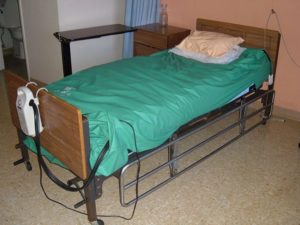Putting a loved one in a nursing home for long-term or end-of-life care is a heart wrenching decision even under the best of circumstances.You want to make sure your loved one receives the best care possible, and yet you don’t know, exactly, what to expect. Your choice of facility may be limited by insurance requirements or financial concerns, or you may not be able to keep as close an eye on things as you would like. Even though you want to trust that the facility you choose will provide the best, most attentive care at all times, the fact is that some nursing homes fall short of expectations. How do you recognize the signs of negligence in a nursing home?
Pressure Ulcers
A glaring sign of negligence in a nursing home setting is the presence of bed sores. Also known as pressure ulcers, bed sores are a common ailment among the bedridden and immobile, even though they are highly preventable. In 2004, 1 in 10 residents in nursing homes were affected by bed sores; the percentage was slightly higher – 14% – for those under the age of 64.
What causes pressure ulcers?
In general, patients who have difficulty changing positions on their own are susceptible to pressure ulcers. A pressure ulcer forms when soft tissue is compressed between a bone and a hard surface, such as a bed or chair, for an extended period of time. The lack of adequate blood flow to the site can cause the affected tissue to die,creating a lesion. This process can happen in as little as two hours for some patients. Common sites for bed sores are the back of the head and ears, shoulders, elbows, lower back and buttocks, hips, inner knees, and heels. Sores can also develop in areas where skin folds over on itself, or where medical equipment puts pressure on the skin, such as with oxygen tubing.
Additional Risk Factors
While individuals with limited mobility are highly susceptible to bed sores, there are other risk factors that can increase the probability a patient will develop these very painful lesions. These risk factors include:
- Thin, fragile, dry skin, such as associated with elderly patients
- Very dry/very moist skin
- Dehydration and/or lack of adequate nutrition
- Bowel or bladder incontinence
- Smoking
- Paralysis/lack of sensory perception
- Lack of mental awareness/lessened mental awareness
- Weight loss associated with illness
- Diabetes or vascular disease
- Muscle spasms
The presence of these risk factors in a nursing home resident does not guarantee they will develop pressure ulcers; it is the lack of proper care that causes bed sores to form.
Treating Bed Sores
The first line of defense in treating bed sores is prevention. This includes regular and frequent repositioning in a bed or wheelchair, keeping the skin clean and dry, and routine examination of skin, particularly in areas where bed sores are commonly seen. Most bed sores begin as a reddened, tender area that may feel warm to the touch. Immediate care of the area can include cleansing the affected skin and use of antibiotics. Unless the affected area is treated right away, the ulcer will progress into damaged tissue. Further progression can result in dead and dying tissue, infection, and, in some cases, death.
If Your Loved One Has Bed Sores
Unfortunately, bed sores can develop due to a lack of proper preventative care, and can be an indication of the negligence of a nursing home toward its residents. Such facilities may be understaffed or have poor hiring practices as well as a lack of proper supervision for resident case management. And if a patient has developed bed sores, it’s possible that other forms of abuse or neglect are present at the facility.
You have a right to expect a high standard of care for your loved one at a nursing home, and if you suspect that your loved one is not getting this high standard of care, you have the right to seek out answers. Seek the advice of an attorney experienced in nursing home negligence issues to get the justice that your loved one deserves.Contact Gerling Law – it won’t cost you a thing to see if we can help!

